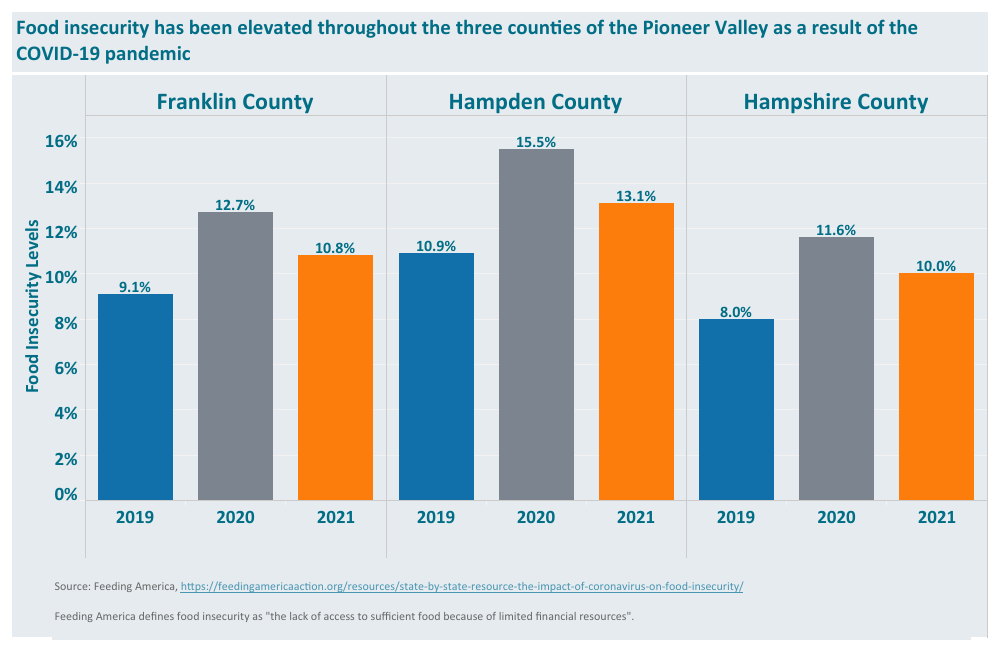News

COVID Recovery Dashboard, “Safety Net, Food, and Hunger in the Pioneer Valley” Highlights Persistence of Food Insecurity
Pioneer Valley Data's second COVID Recovery Dashboard, “Safety Net, Food, & Hunger in the Pioneer Valley”, highlights disturbing increases in food insecurity throughout the Pioneer Valley during the COVID-19 pandemic. Following the surge in unemployment documented in our first COVID recovery dashboard, “How has the COVID-19 Pandemic Impacted Workers in the Pioneer Valley?”, thousands of families in Franklin, Hampshire, and Hampden Counties have been struggling financially, often facing periods of food insecurity or other material hardships. Feeding America, a national non-profit agency working to end hunger in the United States, estimates that each of the three counties of the Pioneer Valley saw substantial increases in food insecurity in 2020, growing 40% in Franklin County, 45% in Hampshire County, and 42% in Hampden County. Food insecurity levels have remained elevated in 2021. In response to this unprecedented spike in need, the many strands of the regional safety net have come together to help Pioneer Valley families weather the economic challenges that have accompanied the COVID-19 pandemic. Two of the most significant strands of support have been programs operated through the Massachusetts Department of Transitional Assistance (especially the Supplemental Nutritional Assistance Program (SNAP, formerly Food Stamps), and food distributed throughout the region by the Food Bank of Western Massachusetts. The Commonwealth of Massachusetts’ Department of Transitional Assistance (DTA) administers programs funded by both the state and federal governments to help families through challenging times. During the COVID-19 pandemic, several programs were expanded, either by increasing the payment levels, altering the qualifications so...

Black and Hispanic/Latino Workers Hit Disproportionately by the COVID-19 Shutdown of the Economy
Labor Day has come and gone, an occasion marked by some of us by enjoying a day off work, while for many others (mostly the same “essential workers” who have continued to step up during the entire “Pandemic Pause”), it was another day of work facing increased risk of infection, often at wages inadequate to support their families. COVID-19 has taken a brutal toll on the people of Massachusetts, costing over 9,400 people their lives statewide, including 988 in the three counties of the Pioneer Valley (Franklin, Hampshire, and Hampden, totals as of 9/28/2020). In addition to the health impact of the pandemic, the economic impact has also been devastating. Nearly six months after initial steps were taken to shut down large portions of the economy in an effort to stop the pandemic from spreading like wildfire, there were still 334,200 people in Massachusetts collecting regular unemployment insurance as of the week ending September 9, including 31,473 claimants in the three counties of the Pioneer Valley. (By comparison, the 10-week average of claims prior to the shutdown was 66,167 statewide, and 7,355 in the Pioneer Valley). [Click through on image to see Tableau Public chart] Black and Hispanic/Latino workers in the Pioneer Valley have been hit particularly hard by the pandemic’s double-fisted health and economic impacts, largely reflecting their disproportionate employment in sectors hardest hit by the shutdown. In the first two weeks of March, prior to the pandemic shutdown, Black and Hispanic/Latino workers accounted for...

Community Resilience in the Pioneer Valley
The U.S. Census Bureau recently released a new set of community resilience indicators, which measure “the capacity of individuals and households to absorb, endure, and recover from the health, social, and economic impacts of a disaster such as a hurricane or pandemic.” Just as COVID-19 has hit some of our communities harder than others, the ability to bounce back from the health and economic impacts of the deadly pandemic will also vary substantially. Knowing which people face the greatest challenges will help us to focus resources where they are most needed. Across the Pioneer Valley (Franklin, Hampshire and Hampden Counties), more than one quarter of all residents (186,000 people) have three or more risk factors as identified by the US Census Bureau. About one in four (162,000) have no risk factors, while the balance, about half of residents in the Pioneer Valley, have one or two risk factors. Of the 45 Census Tracts in the Pioneer Valley in which at least one in three residents have three or more risk factors, almost all fall within the boundaries of Hampden County’s four Gateway Cities – Westfield, Holyoke, Chicopee, and Springfield. (See Figure 2). Outside of Hampden County there are just four such tracts: three in Hampshire County (one in Amherst, and two in Northampton), and one in Franklin County (in Greenfield). The Census Bureau methodology drills down at the Census Tract level, categorizing residents within each census tract according to the number of risk factors each person faces. They identify a...

The Paycheck Protection Program (PPP) Lifeline in the Pioneer Valley
With the economy heading for a cliff the second week of March, none of us knew what to expect. At least initially concerns over the health impacts of COVID-19 took center-stage, as Massachusetts employers responded to this unprecedented shock to our economy. Policy makers quickly recognized that public health considerations needed to take precedent—at least for a while—resulting in a body blow to the national economy and the economies of every state. Most states took measures to at least partially close down their economies to all but “essential services”. Here in Massachusetts, Governor Baker ordered the closure of non-essential service businesses as of noon, March 24th, 2020, two weeks after declaring a state of emergency throughout the Commonwealth due to the Coronavirus outbreak. At the federal level, the bipartisan CARES Act that was signed into law on March 27, included several provisions to soften the blow for businesses and individuals harmed by the economic shutdown. The establishment of federally backed loans through the Small Business Administration (SBA), in the form of the Paycheck Protection Program [https://www.sba.gov/funding-programs/loans/coronavirus-relief-options/paycheck-protection-program] was one of the most substantial elements, a $650 billion initiative intended to help businesses survive and their employees continue to make ends meet. Throughout the Pioneer Valley, thousands of businesses (8,673) were extended loans through the PPP, allowing them to retain an estimated 100,1001 workers (36,000 via loans of less than $150,000, and 65,000 via loans of $150,000 or more). Because the publicly available information for PPP loan recipients is different...
